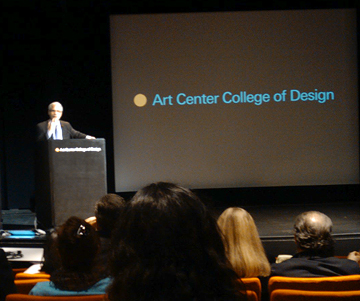Art Center President Lorne Buchman unveiled Art Center’s new strategic plan last night to the College community. (Read our live tweets for the event on Twitter.)
 The five-year strategic plan represents the culmination of more than a year of deep conversations, brainstorms and working group sessions with the entire Art Center community—students, faculty, staff, alumni, trustees and friends—that explored the intrinsic qualities of the great art and design college of the future. A website has been created as well that will explain the plan and track progress.
The five-year strategic plan represents the culmination of more than a year of deep conversations, brainstorms and working group sessions with the entire Art Center community—students, faculty, staff, alumni, trustees and friends—that explored the intrinsic qualities of the great art and design college of the future. A website has been created as well that will explain the plan and track progress.
Also revealed was the College’s new mission statement: Learn to create. Influence change.
The strategic planning process coincided with the first full year of Buchman’s tenure, as well as the College’s 80th anniversary and related celebrations. The timing of this process gave the community opportunities to consider the College’s distinguished past while embracing the future.
Art Center’s five-year strategic plan offers a roadmap for getting there. The plan is organized into three broad pillars that align with Art Center’s mission: “The Conservatory Spirit,” “Convening Diverse Communities & Disciplines” and “New Spaces for Learning.”
The Conservatory Spirit
The first pillar, “The Conservatory Spirit,” reflects Art Center’s longstanding commitment to serve as the foremost college of higher learning for ambitious artists and designers to master their craft and learn from experts in their respective fields. To ensure Art Center’s programs remain on the leading edge and that students are prepared for leadership in a pluralistic society, the strategic plan calls for the expansion of transdisciplinary learning among students from different disciplines, as well as the creation of new undergraduate, graduate and public programs that will address emerging fields and provide students with additional opportunities for growth.
Convening Diverse Communities & Disciplines
The second pillar, “Convening Diverse Communities & Disciplines,” centers on the need to nurture a diverse and robust College com-munity of students, faculty and staff (in terms of culture, identity and socio-economic status.) Increasing the number of student scholarships is but one vital aspect of creating a more diverse community on campus. In addition, Art Center plans to offer a broader range of disciplines and partnership opportunities with industry and nonprofits that will aid in students’ creative development.
New Spaces for Learning
Equally important, students must have access to the types of learning environments—both physical and online—that will foster collaborations among the various art and design disciplines. The plan’s third pillar, “New Spaces for Learning,” calls for the improvement and development of Art Center’s South Campus in downtown Pasadena as well as a thorough renovation of the College’s Ellwood Building at Hillside Campus to replace outmoded and inefficient systems and materials. The plan also calls for the creation of online education programs and tools to expand and support curriculum and encourage new modes of learning.
Through these various initiatives and resolutions, the strategic plan will position Art Center to shape and define culture, to encourage relevance and social responsibility in art and design, to prepare graduates for leadership roles in society, and to advance learning, research and making. Our collective efforts, together with support from our partners and advocates, will make Art Center the leading college of art and design for the 21st century.
The full text of Art Center’s 2011–16 strategic plan is available online at artcenter.edu/createchange. Also, check out our live tweets from the event.








